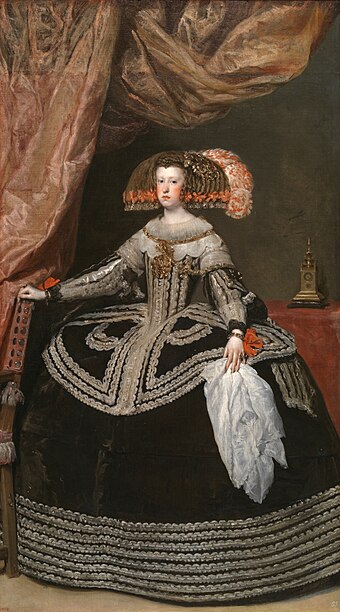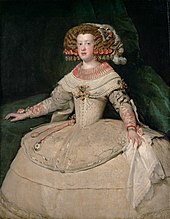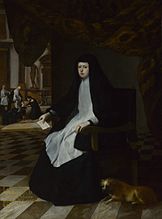Portrait of Mariana of Austria
| Portrait of Mariana of Austria | |
|---|---|
 | |
| Artist | Diego Velázquez |
| Year | 1652–1653 |
| Medium | Oil on canvas |
| Dimensions | 234.2 cm × 131.5 cm (92.2 in × 51.8 in) |
| Location | Museo del Prado, Madrid |
Portrait of Mariana of Austria is a 1652–1653
Mariana had been
Velázquez completed a series of portraits of the Spanish royal family in the 1650s.
Background
Mariana was born on 21 December 1634 in
Realising that the hegemony of the Habsburg dynasty was at stake,[8] Philip proposed marriage to Mariana, his niece. Mariana was described by art historian Rose-Marie Hagen as a "ruddy-cheeked, naive girl who loved a good laugh",[9] and her day-to-day courtly duties came to weigh heavily on her, not least the pressure to produce a male heir.[4]
The marriage was initially viewed as a success by the
Mariana had a difficult life. She and Philip did not know each other before their marriage, and found little in common. The marriage presented many difficulties for the royal court. He was over 40, she was 19, and her bid to provide Philip with a male heir in a family whose sons tended to be sickly,
Description

Velázquez sought to reinvigorate 16th-century court portraiture, which was then, according to art historian Javier Portús, "petrified into a rigid format ... with its clichés of gesture and deportment".[17] As an official court portrait, the painting adheres to convention, with every attempt made to convey a sense of Mariana's majesty.[18] Her extravagant taste in clothes and jewellery is evident, but a modern view is that she was a rather plain looking woman in an unhappy marriage, perhaps lacking in much of the elegance that Velázquez attributed to her.[19]
The painting is composed of harmonious shades of whites, blacks and reds.[20] The scarlet velvet curtain lends the painting a theatrical air.[21] Its material and colour are similar to the long table behind her, on top of which is placed a gilt clock in the shape of a tower.[19] The chair and table signify her royal status, while the clock draws attention to her duties as Queen consort[18] and suggests the virtue of prudence.[20]
Velázquez seemingly conducts an in-depth examination of Mariana's character.[22] She is depicted as elegant and extravagantly dressed in the height of contemporary fashion, but with a sulky expression. According to Hagen, Mariana felt constricted by the demands of court, and suffered from "boredom, loneliness, home-sickness and illness in consequence of her never ending pregnancies [which] transformed the lively girl into that willful, mulish German".[9] Her pout reappears in several of Velázquez's later portraits, including Juan Bautista Martínez del Mazo's 1666 Mariana of Spain in Mourning, painted just after her husband died and the year her daughter Margarita, then twelve, was sent to marry her uncle, Emperor Leopold I.[23]

The subject has an unusually rigid and stiff pose; her upper body and head seem to almost suffocate underneath her black dress.[24] The dress is supported by a wide and stiff farthingale; its width emphasised by the broad lace collar and the horizontal patterns of its trimmed borders.[22] Her unusually pale skin is heavily painted in rouge, making it almost doll-like under her wig and wide head-dress. Her face is painted with thick brush strokes and layers of opaque paint that thin towards the edges, where they appear, from radiography, to have been applied in quick dabs.[25] Although only 19 years old at the time, she stands in the "formal and upright, Catholic manner" expected of contemporary Spanish royalty.[6]
Mariana holds a lace handkerchief in her left hand. Her farthingale and bodice reflect her interest in high fashion.[4] Her dress is extensively lined with silver braids and decorated with red ribbon.[3] Her many pieces of jewellery include bracelets, gold chains and an elaborate gold brooch pinned on her chest. Her brown hair is adorned with red ribbons and a series of braids that extend widely on either side. She wears a large red and white plume which pictorially acts to frame her face.[3] Her left hand holds a large and elaborately folded white cloth, whose depiction, in its attention to line and abandonment of scale, has been described by art historian Antonio Domínguez Ortiz as "worthy of El Greco".[4]
Commission and dating
Velázquez was then the Spanish crown painter, having been Aposentador mayor del Palacio (officer in charge of palace lodging) since 1652.[26] He operated in a pressurised court under threat from the anti-Catholic Oliver Cromwell, the Catalan revolt, and the withdrawal of Austrian support.[27] He admitted to being drained by his workload,[26] and that his official duties limited the time he could devote to painting;[28] he produced fewer than twenty works during the last eight and a half years of his life. Of these some fourteen survive, mostly of the royal family. The run of portraits began with Philip and Mariana's marriage in 1649, and include canvases of Maria Theresa of Spain and Felipe Prospero, their first two children to live beyond infancy. Felipe died aged 3 years, but portraits of Maria Theresa became in demand among potential suitors when she reached marriageable age.[29]

When Ferdinand III requested a portrait of his daughter, Philip asked Velázquez to return to Madrid from his 1649–1650 visit to Italy as soon as possible.[3] The Prado dates the painting between 1652 and 1653, and the art historian José López-Rey agrees. Josep Gudiol places it at 1652, noting that replicas were completed and distributed during 1652–1653.[30] The replica now in the Musée du Louvre was sent to Ferdinand on 15 December 1652.[3] From this, the painting can be assumed as finished before this date.[31]
Velázquez again painted Mariana after Philip's death in 1665. Imbued with a sense of pathos, his late portraits emphasise the effects of widowhood. Although these portraits are dour and mournful in tone, in person Mariana was engaging and fun loving.
Provenance and copies
The painting was recorded in a 1700 inventory when it was paired with Philip IV in Armour with a Lion, which is now in El Escorial, Madrid,[3] and attributed to members of his workshop. Velázquez's portrait of Philip is unfinished; some sections, including the lion, are described by art historian Julián Gállego as "hardly more than sketched".[33] According to the art historian Georgia Mancini, sometime before 1700, another hand "added a piece of canvas to the top of the original composition and painted the upper part of the curtain", so as it would match the size of Philip's portrait.[3]
Later in life, Velázquez became preoccupied with courtly duties, and tended to paint a bust-length portrait of his sitter from life, leaving the completion of the final work to assistants.
Gallery
-
Half-length workshop copy, Metropolitan Museum of Art, New York
-
Infanta Margarita Teresa in a Blue Dress, 1659. Kunsthistorisches Museum, Vienna. A later variant of Mariana's portrait.
-
Portrait of the Infanta Maria Theresa of Spain, 1653. Kunsthistorisches Museum, Vienna. Note the very similar hair, pose, dress and handkerchief.
-
National Gallery, London
References
Notes
- ^ The Habsburgs maintained their political advantage due to strategic marriages, especially between their Spanish and Austrian branches.[1]
- ^ That work shows Mariana in a black and silver dress adorned with silver braid and red bows.[3]
- ^ Felipe's 1659 portrait is described by Ortiz as "the most moving of Velázquez's portraits".[4]
Citations
- ^ Mitchel (2013), pp. 175–191
- ^ Prohaska (2007), p. 230
- ^ a b c d e f g h i Mancini (2007), p. 226
- ^ a b c d e f Ortiz, Gallego (1989), p. 248
- ^ Justi (1889), p. 327
- ^ Royal Collection Trust. Retrieved 6 October 2019
- ^ a b c "Mariana of Austria (1634–1696), Queen of Spain". Metropolitan Museum of Art. Retrieved 12 January 2018
- ^ Ortiz, Gallego (1989), p. 259
- ^ a b Hagen (2010), p. 396
- ^ Ortiz, Gallego (1989), p. 272
- ^ Ortiz, Gallego (1989), p. 275
- ^ Borobia, Mar. "Portrait of Mariana of Austria, Queen of Spain 1655–1657". Thyssen-Bornemisza Museum. Retrieved 30 November 2019
- ^ a b White (1969), p. 127
- ^ Mitchell (2013), p. 178
- ^ Cruz, Galli Stampino (2013), Birthing Habsburgs
- ^ Mitchell (2013), p. 176
- ^ Carr (2006), p. 238
- ^ a b Gállego (1984), pp. 220–223
- ^ a b Ortiz, Gallego (1989), p. 250
- ^ a b "Queen Mariana of Austria". Museo del Prado. Retrieved 9 November 2019
- ^ Ortiz, Gallego (1989), pp. 250–251
- ^ a b Portus (2007), p. 238
- ^ Ackroyd et al (2005), p. 52
- ^ Anderson (2002), p. 171
- ^ Ackroyd et al (2005), p. 48
- ^ a b White (1969), p. 124
- ^ White (1969), p. 123
- ^ White (1969), p. 125
- ^ Ortiz, Gállego (1989), p. 240
- ^ Ortiz, Gallego (1989), p. 244
- ^ Morán; Rudolf (1992), pp. 291–292, 301
- ^ Ortiz, Gallego (1989), p. 131
- ^ a b Ortiz, Gallego (1989), p. 248
- ^ "Infanta Maria Theresa". Museum of Fine Arts, Boston. Retrieved 13 October 2019
- ^ "Mariana of Austria, Queen of Spain". Ringling Museum of Art. Retrieved 22 February 2019
Sources
- Ackroyd, Paul; Carr, Dawson; Spring, Marika. "Mazo's 'Queen Mariana of Spain in Mourning'". London: National Gallery Technical Bulletin, Volume 26, 2005
- Anderson, James. Daily Life During the Spanish Inquisition. Westport CT: Greenwood, 2002. ISBN 978-0-3133-1667-8
- Carr, Dawson. Velazquez. New Haven, CT: Yale University Press, 2006. ISBN 978-1-8570-9303-2
- Cruz, Anne; Galli Stampino, Maria (eds). Early Modern Habsburg Women. London: Routledge, 2013. ISBN 978-1-3155-7847-7
- Gállego, Julián. "Visión y símbolos en la pintura española del Siglo de Oro". Madrid: Cátedra, 1984
- Justi, Carl. Diego Velazquez and His Times. London: H Grevel and company, 1889
- Hagen, Rose-Marie. Masterpieces in Detail. London: Taschen, 2010. ISBN 978-3-8365-1549-8
- Mancini, Giorgia. In Carr, David (ed). Velázquez. London: National Gallery, 2007. ISBN 978-1-8570-9303-2
- Mitchell, Silvia. "Habsburg Motherhood: The Power of Mariana of Austria, Queen Regent for Carlos II of Spain". Farnham: Ashgate: Women and Gender in the Early Modern World Series, 2013. ISBN 978-1-4724-1165-5
- Morán, Miguel; Rudolf, Karl. "Nuevos documentos en torno a Velázquez y a las colleciones reales". Archivo español de arte, 65, 1992
- ISBN 978-0-8109-3906-6
- Portus, Javier. In Carr, David (ed). Velázquez. London: National Gallery, 2007. ISBN 978-1-8570-9303-2
- Prohaska, Wolfgang. In Carr, David (ed). Velázquez. London: National Gallery, 2007. ISBN 978-1-8570-9303-2
- White, Jon Manchip. Diego Velázquez: Painter and Courtier. London: Hamish Hamilton, 1969. ISBN 978-0-2410-1624-4
External links






